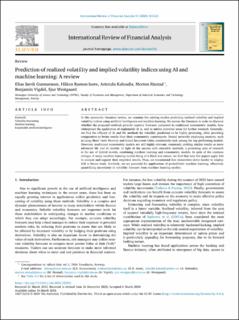| dc.contributor.author | Gunnarsson, Elias Søvik | |
| dc.contributor.author | Isern, Håkon Ramon | |
| dc.contributor.author | Kaloudis, Aris | |
| dc.contributor.author | Risstad, Morten | |
| dc.contributor.author | Vigdel, Benjamin | |
| dc.contributor.author | Westgaard, Sjur | |
| dc.date.accessioned | 2024-04-05T10:42:20Z | |
| dc.date.available | 2024-04-05T10:42:20Z | |
| dc.date.created | 2024-03-26T09:37:19Z | |
| dc.date.issued | 2024 | |
| dc.identifier.issn | 1057-5219 | |
| dc.identifier.uri | https://hdl.handle.net/11250/3125056 | |
| dc.description.abstract | In this systematic literature review, we examine the existing studies predicting realized volatility and implied volatility indices using artificial intelligence and machine learning. We survey the literature in order to discover whether the proposed methods provide superior forecasts compared to traditional econometric models, how widespread the application of explainable AI is, and to outline potential areas for further research. Generally, we find the efficacy of AI and ML methods for volatility prediction to be highly promising, often providing comparative or better results than their econometric counterparts. Neural networks employing memory, such as Long–Short Term Memory and Gated Recurrent Units, consistently rank among the top performing models. However, traditional econometric models are still highly relevant, commonly yielding similar results as more advanced ML and AI models. In light of the success with ensemble methods, a promising area of research is the use of hybrid models, combining machine learning and econometric models. In spite of the common critique of many machine learning models being of a black-box nature, we find that very few papers apply XAI to analyze and support their empirical results. Thus, we recommend that researchers strive harder to employ XAI in future work. Similarly, we see potential for applications of probabilistic machine learning, effectively quantifying uncertainty in volatility forecasts from machine learning models. | en_US |
| dc.language.iso | eng | en_US |
| dc.publisher | Elsevier | en_US |
| dc.rights | Navngivelse 4.0 Internasjonal | * |
| dc.rights.uri | http://creativecommons.org/licenses/by/4.0/deed.no | * |
| dc.title | Prediction of realized volatility and implied volatility indices using AI and machine learning: A review | en_US |
| dc.title.alternative | Prediction of realized volatility and implied volatility indices using AI and machine learning: A review | en_US |
| dc.type | Journal article | en_US |
| dc.type | Peer reviewed | en_US |
| dc.description.version | publishedVersion | en_US |
| dc.source.volume | 93 | en_US |
| dc.source.journal | International Review of Financial Analysis | en_US |
| dc.identifier.doi | 10.1016/j.irfa.2024.103221 | |
| dc.identifier.cristin | 2257294 | |
| dc.relation.project | Norges forskningsråd: 314609 | en_US |
| cristin.ispublished | true | |
| cristin.fulltext | original | |
| cristin.qualitycode | 1 | |

